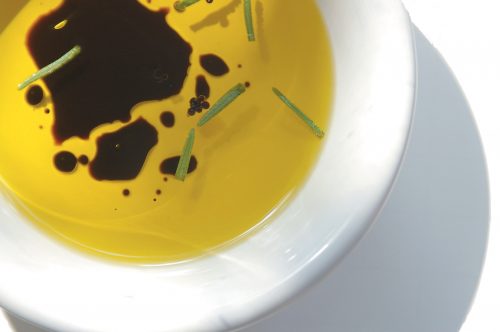
We guide you through the many options available on the salad dressing shelf and help you choose dressings that suit you.
A salad isn’t a salad until it’s dressed. From the decadently rich and creamy to the tangy and light, your choice of dressing can make a big difference to the kilojoule content of your meal.
Vinaigrette
A traditional vinaigrette, also known as French dressing, is essentially an oil and vinegar (and/or lemon juice) blend with added salt and pepper and perhaps some herbs and mustard for added tang. The oil is normally mixed 3:1 to the vinegar, although when lemon juice is used it can be closer to 1:1. As we all know, oil and water don’t mix, and so it is with oil and vinegar: they will separate when left to settle so a vinaigrette is always mixed immediately before dressing the salad. For this reason, commercial products can add an emulsifier which stops them separating (although a good shaking before use is always an option).
Mayonnaise
Traditional egg mayonnaise, the creamiest dressing of all, is made by blending oil, vinegar (or lemon juice) and egg yolk – which acts as the emulsifier to hold it together in its creamy splendour – and then seasoned to taste.
A 20ml serve (that’s equivalent to a heaped tablespoon or four teaspoons) of a traditional vinaigrette or mayonnaise would provide around 550kJ. It is worth remembering that the oil used in dressings can be healthy (see How to choose: Salad and cooking oils for more information), but if you’re watching your weight you’ll be pleased to find there are low-fat, low-kilojoule options that can still enhance your salad.
If you can afford the ‘full monty’ kilojoule-wise, there’s more good news for you: the fat in the dressing actually helps to absorb the nutrients in the salad ingredients. Researchers who compared the absorption of antioxidant carotenoids (alpha-carotene, beta-carotene and lycopene) from salads with different dressings observed more absorption of carotenoids when salads were eaten with full-fat rather than reduced-fat salad dressing.
In another study, where different oils and vinegars were tested, dressings made with olive oil and apple cider or wine-based vinegars increased the antioxidant activity of the salad the most.
Ready-made options
It may not exactly be how they are marketed, but you could categorise ready-made salad dressings in terms of their fat content, which ranges from (virtually) ‘no-fat’ to (very) ‘high-fat’.
Lower fat options
The (virtually) ‘no-fat’ dressings can contain quite a lot of water (remember that ingredients are listed from highest to lowest weight on the label), with their flavour based on the vinegar plus flavourings like garlic, herbs and salts. For the kilojoule-conscious these are guilt-free: the ones we bought ranged from 46-97kJ for a 20ml serve. That’s very little energy for a lot flavour.
Higher fat options
I would put anything over 20% fat in the high-fat category, even though that still leaves an enormous range of different products. Remember that a traditional homemade mayonnaise or vinaigrette is about 75% fat (13% saturated fat), so I’m not implying these are inherently evil products that are setting out to undermine your health and happiness. But they are high in fat and should be treated accordingly. That means small portions and, for many people at least, they’re not something to indulge in every day. Save the high-fat ones for that special occasion recipe and make your everyday dressing a lower-fat choice.
Middle-of-the-road options
There are a number of products in the 4% to15% fat range. The Eta Lite & Free sour cream and chives dressing was a cream-style dressing with only 4.6% fat with quite a light, yet still creamy, texture; and the Paul Newman’s Own light sesame ginger dressing had 14.6% fat yet it had loads of flavour without too much added sugar (often the trade-off).
There are a huge range of products and flavours available, so it’s worth taking the time one day to have a bit of a hunt for a product style, flavour, fat and sodium content that will meet your and your family’s needs.
Sodium
There was a big difference in the sodium content of the dressings, so if you’re watching your sodium intake, look for ones with less than 1000mg per 100g (of course lower is better).
Sugar
Most of these products have added sugars to improve their palatability, although some of the very high-fat products had virtually no sugar. My preference would be for less than 15% sugars, but it might be a trade-off with the fat content to get the flavour or style you want. If it is, go for the lower kilojoule product.
www.healthyfood.com










